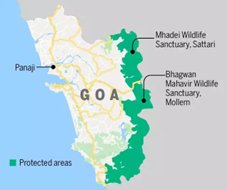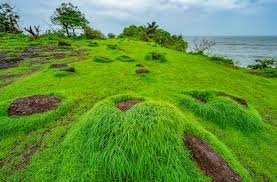PROTECTING GOA’S LATERITIC PLATEAUS
Context:
- Environmentalists in Goa are concerned about an approved eco-tourism resort on the Surla plateau.
- They argue this area is a critical tiger habitat within the Mhadei Wildlife Sanctuary.
- They are calling for protection measures for Goa’s unique lateritic plateaus due to their high ecological value.
GOA’S LATERITIC PLATEAUS: ECOLOGICAL SIGNIFICANCE
- Unique Ecosystems: These are iron-rich rocky outcrops. They are found in the Western Ghats.
- Biodiversity Hotspots: They may appear barren. However, scientific evidence shows they are full of life.
- Endemic Flora: Up to 40% of plants on these plateaus are endemic. They are unique to the region.
- Rare Species: Examples include Dipcadi goaense, a flowering plant. It’s known only from a few Goan plateaus.
- Seasonal Life: They become vibrant with life during the monsoon. They support unique flora and fauna. These species are adapted to harsh conditions.
- Hydrological Importance:
- Groundwater Recharge: Critical for replenishing groundwater.
- Water Sources: They are the source of countless springs and streams. These are vital for homes and agriculture.
THREATS TO LATERITIC PLATEAUS
- Worrying Trend: The Surla plateau project exemplifies a trend. It involves converting fragile plateau ecosystems into concrete structures.
- Mischaracterization as ‘Wastelands’: Officials often wrongly label these areas as ‘wastelands’. This paves the way for their conversion for development.
- Examples of Loss: Other plateaus like Verna, Kundaim, and Bambolim are already lost. They became industrial estates and urban developments.
- Surla Plateau Project Concerns:
- Critical Tiger Habitat: The project area is within the Mhadei Wildlife Sanctuary. This sanctuary is a recognized prime habitat for tigers.
- NTCA Recommendation: The National Tiger Conservation Authority (NTCA) identified Mhadei as a tiger habitat. It recommended its declaration as a Tiger Reserve.
- Habitat Fragmentation: The proposed resort threatens to break up this critical habitat. It will disrupt tiger movement.
- Irreversible Damage: Environmentalists call it a “monumental and irreversible mistake.”
ABOUT MHADEI WILDLIFE SANCTUARY

- Location: Located in the northern part of Goa. It is situated in the Western Ghats.
- Area: Spreads over an area of 208 sq. km.
- Name Origin: Named after the Mhadei River. The river flows across this Sanctuary.
- Waterfalls: Features picturesque waterfalls.
- Most prominent are the Vazra Sakla Falls and the Virdi Falls.
- The cliff near Vazra Falls is a nesting ground for critically endangered Long-billed vultures.
- Highest Peaks: Houses Goa’s three highest peaks.
- Sonsogod (1027 m)
- Talvche Sada (812 m)
- Vagheri (725 m)
- Flora:
- Dense forests are mainly semi-evergreen and moist deciduous.
- Hosts trees like teak, sal, and bamboo. Also has medicinal plants and orchids.
- Known for its sacred groves. These protect rare and indigenous trees.
- Fauna:
- Mammals: Bengal tigers, black panthers, leopards, sloth bears, gaur (Indian bison), and various deer.
- Reptiles: A large variety of snakes. This includes the ‘big four’ Indian venomous snakes: Indian krait, Russell’s viper, Saw-scaled viper, and Spectacled cobra. It attracts herpetologists.
- Birds: Boasts over 250 bird species. Many are endemic to the Western Ghats. Examples include Malabar trogon, great pied hornbill, and Nilgiri wood pigeon.
Note: Connect with Vajirao & Reddy Institute to keep yourself updated with latest UPSC Current Affairs in English.
Note: We upload Current Affairs Except Sunday.

